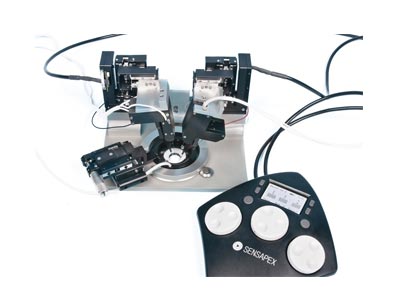When building any structure, whether it’s a bridge or a protein, three elements are required: building materials, energy and building plans. The same is true in biological systems. Proteins are the structural material used for building. They provide the shape and substance of cells, tissues, organs and living matter. Carbohydrates are converted to energy to fuel the cellular building process. If more energy is available than is required for a project, the carbohydrates are converted to fats for long term energy storage. Finally, nucleotides within the nucleus of a cell provide the blueprints for the project.
In Muscle Physiology studies, researchers look into the cell, tissue or organ to observe the biological functions taking place. WPI offers a full line of muscle physiology products, to examine everything from a single cardiac myocyte to an entire organ.
- Biaxial Tissue Analysis :
These units are used in research laboratories for testing skin, ligaments, blood vessels, heart valves, sclera, membranes and scaffolds, really any planar biological material. Get the details here. - Muscle Testers :
Muscle testers, horizontal tissue baths and more for all the muscle physiologist needs. - Muscle Tester Modules :
Find all the electronic components for your muscle physiology system. - SI-H Force Transducers :
The SI-H Force Transducers are designed for use with our SI-H muscle tester platforms and come with a lifetime warranty. - SI-H Tissue Mounts :
G•These mounting devices are used for small tissues with the SI-H line of muscle physiology research muscle testers.
Basics of Muscle Physiology
A Cell – Simplified
While a cell has hundreds of organelles and parts, we are primarily concerned with four parts of a cell.
Mitochondria – This is the powerhouse found in all cells. It’s like a tiny battery. It turns carbohydrates into usable energy for building.
Nucleus – The center of the cell is full of DNA and RNA, the nucleotide blueprints.
Ribosomes – These are tiny factories or biological robots that check out RNA from the nucleus library. The ribosomes read the RNA like ticker tape, processes it and spits out a string of amino acids to form specific proteins. Over 500,000 unique proteins can be found in the human body.
Endoplasmic Reticulum–The ER creates a highway system throughout a cell. It is a complex system of tubes that transport proteins through the cell. In muscle cells, this is called the sarcoplasmic reticulum.
Organization in Living Systems
The single cell is the basic unit of living matter. A group of cells that perform the same function are called a tissue. Different types of tissues that work together to perform a single function are defined as an organ. Groups of organs working together form a system. Multiple systems working together form an organism.
Muscle Cells
Animals have three types of muscle cells. Striated muscles are the voluntary muscles that attach to bones. We control these muscles with conscious thought. They appear striped when you look at them under a microscope. Smooth muscles are the involuntary muscles that are not controlled by conscious thought. Rather, they are controlled in response to hormones, ionic compounds, reactions from neighboring cells and the autonomic nervous system. Smooth muscle is found in all the hollow organs (for example, stomach, uterus, bladder, intestines) and all blood vessels. Cardiac muscle is found only in the heart. While heart rate can change in response to stimuli, cardiac muscle contracts independently as long as it’s alive.
All three types of muscles have a few similarities. All muscles have two proteins, actin and myosin, which form cross bridges and cause the muscle to contract and expand. Because of the large amounts of energy they require, all muscle cells have a large number of mitochondria in the cells. Calcium (Ca2+) facilitates contraction in all muscle cells.
The sacroplasmic reticulum has T-tubules that distribute calcium across the length of the muscle cell. At the neuro-muscular junction (where a nerve cell meets a muscle), an electrical event on the surface of the muscle occurs that causes a release of calcium and subsequent muscle contraction. Skeletal and heart muscles are composed of basic contractile units called sarcomeres. Sarcomeres give these muscles their characteristic striated appearance.

